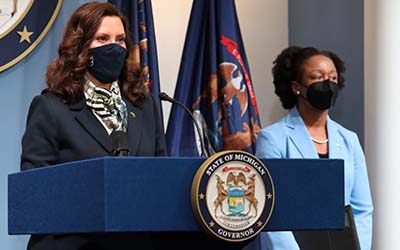
by Becky Andrus | May 17, 2021 | Uncategorized
Covering all 23 OAA teams with insight and thoughts on each school from Northern Oakland County, Southern Oakland County, and one from Wayne County.
Thursday, May 13, 2021

Boys Lacrosse Regional Preview.
Written Thursday May 13th at 10:05 AM
Here are is my insight and picks for the regionals for boys lacrosse.
Region 4 @ Lakeland
- Northville vs. 8. WEST BLOOMFIELD
- White Lake vs. 5. Livonia Stevenson
- Walled Lake vs. 7. FARMINGTON
- South Lyon vs. 6. Novi
INSIGHT/PROJECTION: This is shaping up to be a very interesting regional at Lakeland. White Lake could clash with Northville in the regional semifinals pending if they get by Livonia Stevenson. Walled Lake will not have an easy time with Farmington while South Lyon and Novi will be an interesting matchup as well. I think the Mustangs look vulnerable but they should find a way to move on. PICK: NORTHVILLE.
Region 5 @ Troy Athens
- LAKE ORION vs. 8. Waterford
- TROY ATHENS vs. 5. STONEY CREEK
- ADAMS vs. 7. TROY
- BLOOMFIELD HILLS vs. 6. ROCHESTER
INSIGHT/PROJECTION: This is shaping up to be an interesting regional at Troy Athens. Imagine the host school taking on Lake Orion on their home field in the regional semifinals, which could happen. Adams has been rolling as well. I’m seeing this being a Dragons vs Highlanders regional final with Lake Orion moving on. PICK: LAKE ORION.
Region 6 @ Seaholm
- Birmingham Brother Rice vs. 8. Sterling Heights Stevenson
- Detroit Cass Tech vs. 5. Chippewa Valley
- BIRMINGHAM vs. 7. Warren United
- Detroit University of Detroit-Jesuit vs. 6. Utica Ford II
INSIGHT/PROJECTION: This is shaping up to be a very interesting regional final should both teams get there at Seaholm. Birmingham United and Birmingham Brother Rice are on a collision course. The Warriors have a great path to the regional finals. The Bulldogs have to beware of Detroit University-Detroit Jesuit in the regional semifinals. I think this will be a Birmingham Brother Rice/Birmingham United regional final but it will be the Warriors that moves on. PICK: BIRMINGHAM BROTHER RICE.
Region 8 @ Oxford
- Holly/Brandon vs. 9. Lapeer
- Holly/Brandon/9. Lapeer vs. 1. CLARKSTON
- OXFORD vs. 5. Saginaw Heritage
- Midland vs. 7. Davison
- Grand Blanc vs. 6. Linden
INSIGHT/PROJECTION: This is shaping up to be an interesting regional at Oxford. Clarkston has a nice path to the district finals while Midland and Grand Blanc should be very interesting. I think the Bobcats will pull off the shocker over Midland and meet the Wolves in the regional final. End of the day though too much Clarkston. PICK: CLARKSTON.
Region 14 @ North Farmington
- NORTH FARMINGTON vs. 5. Walled Lake Western
- Pontiac Notre Dame Prep vs. 6. ROYAL OAK
- NORTH FARMINGTON/5. Walled Lake Western vs. 1. Bloomfield Hills Cranbrook-Kingswood
- Pontiac Notre Dame Prep/6. ROYAL OAK vs. 2. Royal Oak Shrine
INSIGHT/PROJECTION: This looks to be a very interesting regional at North Farmington with the three top seeds in this regional was ranked at some time during the season. The favorite should be Bloomfield Hills Cranbrook-Kingswood. The Cranes have had a good season but they should expect a challenge from Royal Oak Shrine in the regional final pending if they can get by Pontiac Notre Dame Prep. At the end of the day I think Bloomfield Hills Cranbrook-Kingswood will be too much. PICK: BLOOMFIELD HILLS CRANBROOK-KINGSWOOD.

by Becky Andrus | May 17, 2021 | Uncategorized
Covering all 23 OAA teams with insight and thoughts on each school from Northern Oakland County, Southern Oakland County, and one from Wayne County.
Thursday, May 13, 2021

Girls Tennis Regional Projections.
Written Thursday May 13th at 10:10 AM
Here is my projections of the girls tennis regionals.
Top Four Teams Go To States, Bold: Projected Team Regional Champions.
Region 4 @ Livonia Churchill
FARMINGTON
SEAHOLM
SOUTHFIELD ARTS AND TECH
Dearborn
Dearborn Edsel Ford
Farmington Hills Mercy
Wayne Memorial
Livonia Churchill
Livonia Stevenson
TEAMS I SEE ADVANCING TO THE FINALS: SEAHOLM, Dearborn, Farmington Hills Mercy, and Livonia Churchill.
Region 5 @ Grosse Pointe South
TROY
TROY ATHENS
ROYAL OAK
Dearborn Fordson
Detroit Cass Tech
Fraser
Grosse Pointe South
Warren Mott
Sterling Heights
Sterling Heights Stevenson
TEAMS I SEE ADVANCING TO THE FINALS: TROY, Grosse Pointe South, TROY ATHENS, and Dearborn Fordson.
Region 6 @ Utica Eisenhower
STONEY CREEK
Chippewa Valley
Macomb Dakota
Macomb L’Anse Creuse North
Anchor Bay
Port Huron Northern
Romeo
Utica
Utica Eisenhower
Utica Ford II
TEAMS I SEE ADVANCING TO THE FINALS: Utica Eisenhower, Port Huron Northern, STONEY CREEK, Anchor Bay.
Region 7 @ Clarkston
BLOOMFIELD HILLS
CLARKSTON
LAKE ORION
OXFORD
ROCHESTER
ADAMS
WEST BLOOMFIELD
Lakeland
Walled Lake Central
Walled Lake Northern
TEAMS I SEE ADVANCING TO THE FINALS: BLOOMFIELD HILLS, ROCHESTER, ADAMS, CLARKSTON.
Region 12 @ North Farmington
AVONDALE
BERKLEY
GROVES
NORTH FARMINGTON
Detroit Renaissance
Dearborn Heights Crestwood
Redford Thurston
Livonia Franklin
Birmingham Marian
TEAMS I SEE ADVANCING TO THE FINALS: GROVES, BERKLEY, Birmingham Marian, NORTH FARMINGTON.
Region 13 @ Grosse Pointe North
FERNDALE
Detroit Mumford
Grosse Pointe North
Hamtramck
Macomb L’Anse Creuse
Port Huron
St. Clair Shores Lakeview
Warren Woods Tower
Warren Cousino
TEAMS I SEE ADVANCING TO THE FINALS: Grosse Pointe North, St. Clair Shores Lakeview, Warren Woods Tower, Macomb L’Anse Creuse.

by Becky Andrus | May 12, 2021 | Uncategorized

LANSING, Mich. — Governor Gretchen Whitmer and Michigan Department of Health and Human Services (MDHHS) Chief Medical Executive Dr. Joneigh Khaldun provided an update on vaccine rollout and the MI Vacc to Normal Challenge. They were joined by Dr. Srikar Reddy, President-Elect of the Michigan Academy of Family Physicians, and John Walsh, President and CEO of the Michigan Manufacturers Association.
The Governor praised Michigan’s progress on vaccinations. Michigan has reached the first milestone of the ‘MI Vacc to Normal’ plan, and the Governor anticipates that MIOSHA will take action allowing offices to allow in-person work on May 24. COVID-19 cases and hospitalizations have also decreased since mid-April. She encourages Michiganders who have not gotten vaccinated yet to get their shots as soon as possible.
To view the PowerPoint presentation that the governor used during today’s press conference, click the link below:
See below for photos from today’s press conference:
|

by Becky Andrus | May 3, 2021 | Uncategorized
|
Press Release
FOR IMMEDIATE RELEASE: April 29, 2021
CONTACT: MDHHS, Chelsea Wuth, WuthC@michigan.gov, 517-241-2112
MDARD, Jessy Sielski, SielskiJ@michigan.gov, 517-284-5725
MDNR, Ed Golder, GolderE@michigan.gov, 517-284-5275
MDHHS, MDARD, MDNR offer best practices to minimize risk of rabies after four bats test positive in Clinton, Ingham, Kent, and Midland counties
LANSING, Mich. – The Michigan departments of Health and Human Services (MDHHS), Agriculture and Rural Development (MDARD) and Natural Resources (MDNR) are urging Michiganders to adopt practices to protect their families and animals from rabies. Four bats have tested positive for rabies in Clinton, Ingham, Kent, and Midland counties in 2021.
Spring is typically when rabies cases start appearing. Generally, bats and skunks are a primary source of the disease. Michigan local health departments experience an increase in calls from citizens about bat encounters between May and September when bats are most active. In 2020, there were 56 cases of rabies in Michigan animals including 52 rabid bats and four rabid skunks.
“With warm weather coming, it is possible for Michiganders to unintentionally come into contact with a potentially infected animal,” said Dr. Joneigh Khaldun, MDHHS chief medical executive and chief deputy for health. “If you come into physical contact with a wild animal or are bitten or scratched, it is important that you seek medical care quickly to keep a treatable situation from becoming potentially life-threatening.”
Rabies is a viral disease of mammals and is transmitted through the bite or scratch of an infected animal. Exposures can take place in a variety of settings, including when bats are found in the bedroom of a sleeping person or a child comes into contact with an infected animal. It is important to seek medical care to determine the need for post-exposure treatment.
Rabies is fatal to humans if proper treatment is not received before symptoms begin. Preventive treatment is given to people who are exposed to a potentially rabid animal. Treatment is not necessary for people if the animal can be tested and tests negative for rabies.
To protect your family and your animals from rabies, there are some very important tips to follow.
People:
- People should leave wild and stray animals alone, including baby animals. Animals could be carrying rabies and not appear sick. Do not try to nurse sick wildlife or stray animals to health. Report ill wildlife to the Department of Natural Resources. Contact your local animal control agency with concerns about stray animals.
- If you are bitten or scratched by an animal, promptly seek medical care and notify your local health department about the bite.
- If a person may have been asleep in the same room as a bat, or a young child or person with an impairment may have been alone with a bat, safely confine or collect the bat if possible and contact your local health department to determine if it should be tested for rabies. If the bat escapes or is released, contact your local health department to discuss the situation and determine if treatment of people potentially exposed to the bat is necessary.
Animals:
- Talk to your veterinarian about vaccinating pets and livestock. Even indoor pets that never go outside can encounter a bat that gets inside the home. Rabies is fatal in animals, and there is no treatment. Therefore, vaccination is important to protect your pets and livestock from rabies.
- If your animal is bitten, scratched or may have been unsupervised with a wild or stray animal, contact your veterinarian as soon as possible. Even if your animal is currently vaccinated against rabies, additional actions may need to be taken to prevent the spread of the virus. If possible, safely confine or capture the wild or stray animal without touching the animal. Then, contact your local animal control agency or a veterinarian, as the animal may need to be tested for rabies.
- Keep your pet on a leash and under your control as this can reduce the chances of having contact with wild and stray animals.
More information about rabies and a map of rabies positive animals in Michigan can be found at Michigan.gov/rabies. |

by Becky Andrus | Apr 20, 2021 | Regional News, Uncategorized
|

Media Contact:
Kelly Rossman-McKinney
(c) 517-512-9342
FOR IMMEDIATE RELEASE:
Monday, April 19, 2021
AG Nessel Warns Against New Spin on Grandparent, Family Emergency Scam
LANSING – Michigan Attorney General Dana Nessel is once again reminding Michiganders to be on alert for grandparent and family emergency scams following recent reports of different variations of this scam. In a consumer alert that was reissued today, Nessel provides tips on how to identify and avoid becoming victims of grandparent and family scams.
In a period of five days, two mid-Michigan mothers each received calls from purported kidnappers demanding a ransom for their daughters’ return. In each instance, the caller knew the daughter’s name and demanded payment by wire. Both were scams.
In an earlier instance, a couple of grandparents were tricked out of $33,000. They wire transferred $3,000 to someone they thought was their grandson after he called and claimed he was caught fishing without a license in Canada and needed to pay a $3,000 fine. They were taken for an additional $30,000 after the supposed grandson called again to say that alcohol and drugs were found when his boat was searched, and he needed $30,000 to post bond to get out of a Canadian jail.
While there are numerous variations of the typical grandparent scam, they are alike in their tactics.
“Bad actors will stop at nothing to get your money or personal information – that includes exploiting your love and concern for your family members,” Nessel said. “My office is committed to ensuring Michiganders are protected from these con artists and that they are aware of best practices to avoid these scams.”
Be suspicious when you receive a telephone call where:
- A child or grandchild calls you from a far away location.
- The grandchild says, “It’s me,” or “It’s your grandson,” or “It’s your favorite grandchild.”
- The child or grandchild is in some trouble or some type of distress.
- The caller asks for money to be wire transferred
If you receive such a call, you should verify the identity and location of the child or grandchild claiming to be in trouble. You should hang up and call another family member who can confirm your child or grandchild’s whereabouts. Try calling them at the telephone number through which you normally reach them. Stay calm and avoid acting out of a sense of urgency. Do not wire money unless you have verified with an independent third party that your child or grandchild is truly in trouble.
In addition, never give out any personal identifying information such as bank account or credit card numbers to anyone who calls you on the phone. Con artists will lie, cheat, steal, and make up plausible stories to convince you to wire money or divulge sensitive information. The callers are often professional criminals who are skillfully able to get you to wire money or give personal information before you have time to properly assess the situation.
If you’ve wired money to a scam artist, call the money transfer company immediately to report the fraud and file a complaint. You can reach the complaint department of MoneyGram at 800-MONEYGRAM (800-666-3947) or Western Union at 800-448-1492.
Then, file complaint with your local police department and the Federal Trade Commission (FTC). Visit the FTC’s website, or call toll-free, 877-FTC-HELP (877-382-4357); TTY: 866-653-4261.
In addition, if the request for money involved a wire transfer to Canada, Canadian officials in the Anti-Fraud Call Center ask victims to report the fraud at their PhoneBusters hotline at 888-495-8501 or on their PhoneBuster’s website.
|

by Becky Andrus | Apr 19, 2021 | Uncategorized

PHOTOS: Lt. Governor Gilchrist Tours Mid-Michigan Vaccination Clinics
LANSING, Mich. — Today, Lt. Governor Garlin Gilchrist traveled to the Central Michigan University vaccination site in Mount Pleasant and the Alma College Vaccination site in Alma to observe ongoing COVID-19 vaccination efforts and ensure that vaccines are being distributed efficiently and equitably. He was joined by Central Michigan University President Bob Davies, Regional Emergency Management Director Marc Griffis, and Alma College President Jeff Abernathy.
“Our administration has been working around the clock to expand our vaccine program in an efficient and equitable manner so that every Michigander has access to the safe and effective vaccines,” said Lt. Governor Gilchrist. “The vaccination efforts like the ones in Mount Pleasant and Alma are crucial to beating COVID-19. I encourage all Michiganders to get vaccinated as soon as possible to protect our friends, family, and neighbors and so we can get back to doing the things we love together.”
To date, Michigan has administered 5,788,119 vaccines, moving the state closer to its goal of equitably vaccinating at least 70% of Michiganders ages 16 and older as soon as possible. As part of these efforts, Michigan is working to administer 100,000 shots per day, partnering with organizations like Central Michigan University and Alma College to create more opportunities for Michigan residents to receive a vaccine.

Central Michigan University visit

Central Michigan University visit

|


















